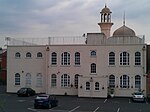City of Birmingham Stadium
The City of Birmingham Stadium was a proposed multi-purpose stadium in the Saltley area of Birmingham, England, originally for Warwickshire County Cricket Club and Birmingham City F.C. to replace the current Edgbaston Cricket Ground and St Andrew's Stadium respectively. The cricket club cancelled these plans however, and only the football club remained interested. The original proposal was the centrepiece of a larger scheme to create a £300 million sports village on a 60-acre (240,000 m2) site.The proposal was for a 55,000-seat arena was to be part-funded by Las Vegas Sands, but the hopes of securing a licence for a super casino on site were rejected and Birmingham City F.C. were then unable to proceed with the plans for the stadium.
Excerpt from the Wikipedia article City of Birmingham Stadium (License: CC BY-SA 3.0, Authors).City of Birmingham Stadium
Adderley Road South, Birmingham
Geographical coordinates (GPS) Address Nearby Places Show on map
Geographical coordinates (GPS)
| Latitude | Longitude |
|---|---|
| N 52.480555555556 ° | E -1.8627777777778 ° |
Address
Birmingham Wheels Adventure Park
Adderley Road South
B8 1AG Birmingham
England, United Kingdom
Open on Google Maps








